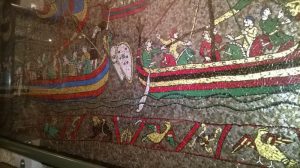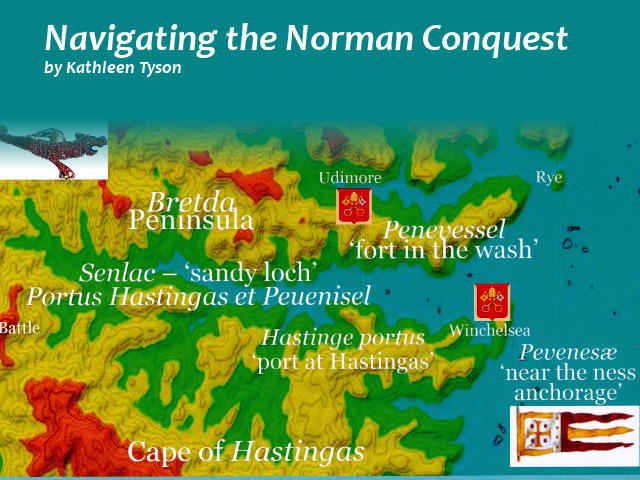Rye Museum hosted a talk by Kathleen Tyson titled “1066: the Navigation of the Norman Conquest” on Thursday June 13. The East Street Museum was sold out for the event and the big doors were closed to prevent overspill.
The 1060s were a complicated time of warring tribes and intricate noble family relationships. In her re-examination of the Battle of Hastings, Kathleen has rejected the fanciful storytelling of the Victorians and returned to the surviving evidence: contemporary written accounts, visual clues in the Bayeux Tapestry and the known geography of the region.

First, geography. The landmass was four to eight metres lower in 1066, so the navigable seascape was very different. Armies of the day moved by water and never strayed far from the coast; ships were shallow and wide and needed to land on sandy beaches so that men and horses could be unloaded at low tide.
This rules out the traditional site of William’s landing, Pevensey, which had no nearby sandy levels. Contemporary maps show half a dozen landing spots in the area suitable for a fleet the size of William’s, perhaps 600 ships. Part of Harold’s army would also have moved by sea and joined the troops that had marched from London at a suitable landing spot.
More suggestions come from the written record. In the Anglo-Saxon Chronicle, it is said Harold camped near a “hoar-apple tree” – Kathleen believes a more likely interpretation of that is “Appledore”. She has spent the past six years translating the Carmen Widonis, an epic poem that is widely accepted as the earliest surviving description of the battle, and sifting it for other clues.
Her working theory? Harold’s army mustered near Appledore, William landed by Lydd and the two armies moved by river or trackway to clash on a hillock somewhere in the Brede Valley – though she doesn’t yet have a firm idea exactly where.
Any proposal to move the Battle of Hastings is bound to be controversial, but Kathleen is an excellent speaker and her ideas were well-presented and persuasive. Afterwards, the many questions from the audience were more curious than sceptical.
The Museum is delighted to have a few copies of Kathleen’s book Carmen Widonis – The First History of the Norman Conquest, for sale at East Street. A slightly revised edition will be coming out shortly, so we can offer the current edition at a reduced price. Kathleen will give this talk again at the Mayfield Local History Society in Tunbridge Wells on March 20, 2020.
This is the last talk of the 2018-19 season. Museum Association Chairman Jo Kirkham will be giving a talk on Rye in the Second World War during the Rye Festival. Posters will go up before the event and non-members are always welcome.
Image Credits: Kathleen Tyson , Heidi Foster .




The talk was videotaped in its entirety and Kathleen has kindly consented to making the video public. The image quality of the speaker isn’t the best, but the audio is clear and her slides are visible. The video can be found on the Museum’s YouTube channel here: https://www.youtube.com/watch?v=SgsyGJHVGjo&t=9s